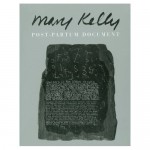 Yesterday I visited Mary Kelly’s retrospective at the Whitworth in Manchester. Kelly’s work uses text and personal narrative to explore themes of identity, memory and sexuality. Her more recent work carves words and scraps of narrative into built structures, using light or mirrors to enable you to read the words. Her earlier work collected objects and texts to re-present memories and stories.
Yesterday I visited Mary Kelly’s retrospective at the Whitworth in Manchester. Kelly’s work uses text and personal narrative to explore themes of identity, memory and sexuality. Her more recent work carves words and scraps of narrative into built structures, using light or mirrors to enable you to read the words. Her earlier work collected objects and texts to re-present memories and stories.
The work that most held my attention was the iconic Post-Partum Document 1973-79. This piece filled an entire gallery, and was a six-year exploration of her relationship with her son, from birth to starting school. Considering its age, the work looked as pristine as if it had been made yesterday. I suspect it may have been carefully remounted and presented. The first part consisted of tiny wool vests, annotated with diagrams and text and presented in Perspex units. The next section showed a month’s worth of stained nappy liners with analysis of the food consumed by the infant, presented in Perspex. Walking along the 31 units, all meticulously dated, I started to feel some of the monotony of feeding and changing, hour after hour, day after day, along with the paranoid concern about whether the baby is getting the right nutrition or eating the right amount. The boredom and responsibility of motherhood.
Next up was a set of ‘Analysed utterances and related speech events’, using printing blocks and typewritten text to recreate the first words spoken by the child, along with the context of the conversation and an analysis of the ‘purpose’ of the words spoken (existence, non-existence, absence, etc). Throughout Post-Partum document, Kelly uses three voices – the child, her own, and that of the ‘analytic observer’. ‘Transitional Objects, Diary and Diagram’ 1976 presented imprints of the child’s body in clay along with scraps of cotton and diary extracts. However, it was the ‘Classified Specimens, Proportional Diagrams, Statistical Tables, Research and Index’ 1977 that I found mesmerising. Objects collected by the child (often beautiful in their own right, such as moths and beetles) were presented alongside a diary of the child’s exploration of genitals and gender recounted through scraps of dialogue. Finally, the introduction of the child’s schooling was presented on slates, with reproduction of the child’s first letters; the artists’ account of the trials of finding appropriate nursery and school; and the way letters are taught (‘a’ is for apple)
The pieces follow the path of child development theories of Freud, Winnicott and Klein, which Kelly would clearly have been aware of. I found myself wondering how reliable a narrator she was, yet at the time this piece was made I’m guessing the artist may not have had the post-modern ‘knowingness’ that we have now come to expect. I was interested in how the traces of childhood were ‘captured’ in a completely different way to snapshots, using physical traces (the faecal stains and clothing), words (the child’s and artist’s) and other ephemera (the collected objects). As an observer I didn’t feel at all voyeuristic, and yet I did feel I had shared an important part of the artist’s life in some way. This was achieved with the ‘distancing’ of the museum exhibit alongside the intimacy of the personal diary extract.
I feel privileged to have seen this piece in its entirety, as there is no way it can be effectively experienced in print form. It also made me wonder whether her work had influenced other artists who are favourites of mine such as Annette Messager and Sophie Calle, as Kelly’s work was highly influential in the development of conceptual and feminist art.
‘Mary Kelly: Projects 1973-2010’ is on at the Whitworth Art Gallery in Manchester from 19 Feb to 12 June 2011.
You can see some images of Post-Partum Document on this website.
Like your hair shorter Carole! When did you get it cut?
Hi Julie! I got it cut when I got a job I started going to the hairdresser again last September, and it’s just been getting shorter ever since. Hope you are well?
I started going to the hairdresser again last September, and it’s just been getting shorter ever since. Hope you are well?
Carole